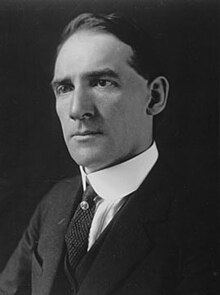Frederick Gardner Cottrell
| Frederick Gardner Cottrell | |
|---|---|

Frederick Gardner Cottrell.
|
Frederick Gardner Cottrell (January 10, 1877 – November 16, 1948) was an American Physical Chemist, Inventor and Philanthropist. He is best known for his invention of the electrostatic precipitator, one of the first inventions designed to eliminate air pollution—and for establishing Research Corporation for Science Advancement, a foundation that has funded scientific research since 1912.
A native of Oakland, California, Cottrell’s immense curiosity gained him notice early in life. One acquaintance said, “He read textbooks like novels.” He finished high school at age 16, entered the University of California, Berkeley, and graduated in 3 years. After graduation, he taught chemistry at Oakland High School, saving money (his annual salary was $1,200) until he could afford to continue his formal education. A notation in his diary, dated January 15, 1900, reads: “Week for lunch and yard duty at school.”
At the time, it was common for American scientists to conduct their graduate studies abroad. To that end, Cottrell left for Europe in July 1900 on the German steamer Waesland, and made land in England where he visited the “Cavendish labs…Hyde Park, Kensington Gardens, House of Parliament, Westminster Abbey and the Crystal Palace” in London; and “the Bodleian Library, Sheldonian Theatre and the Ashmolean Museum of Art and Archaeology” in Oxford.
Then he went to Paris where he visited the Exposition Universelle, the 1900 world’s fair designed to celebrate the achievements of the past century and to accelerate development into the next. There, Cottrell saw the new Eiffel Tower (“[went] to summit”), and visited “Old Paris.” His diary entry on August 11 notes: “got up at 5 a.m. on account of bed bugs. Shook out and packed up things and made arrangements… to change room.”
...
Wikipedia
